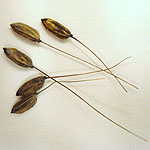The Basics

Rice is a crop that is central to the diet of billions of people. Since its earliest cultivation about 10,000 years ago, the history of rice has been intertwined with that of humans. The thousands of varieties of cultivated rice (Oryza sativa) that exist today contain a wealth of genetic diversity, but an even greater reservoir of genetic variation is found among the wild relatives of rice, such as Oryza rufipogon.
Populations of Rice

Rice accessions can be grouped into species, sub-populations and ecotypes. There are 22 recognized species of Oryza, two of which are cultivated. The cultivated species include O. sativa, known as Asian rice, and O. glaberrima, or African rice. Cultivated Asian rice (O. sativa) is divided into two major varietal groups: indica and japonica, and there are five well differentiated sub-populations. The indica varietal group contains the indica and aus sub-populations, and the japonica varietal group contains the tropical japonica, temperate japonica and aromatic or basmati sub-populations. Read more
Plant Breeding

Traditional plant breeding has used a variety of techniques to exploit the genetic diversity of rice to develop new varieties with different traits. Traditionally, almost all rice varieties are developed as inbred lines, and rice breeders generally focus on crosses between members of the same sub-population. This is because genetic barriers make it difficult to obtain fertile offspring when different sub-populations are crossed, and because the different sub-populations are optimized for specific grain quality and adaptive traits. In contrast, hybrid rice breeding, which has been very successful in China, has drawn on a wider range of genetic diversity by crossing members of different sub-populations of rice. Other techniques, such as "wide hybridization" and embryo rescue are also employed to import desirable traits from exotic species of rice. Read more
Utilizing Genetic Diversity

New techniques can utilize the genetic diversity found in the wild ancestors of rice. These wild ancestors do not usually show desirable characteristics for a cultivated crop plant. However, when wild species are crossed with elite cultivars of rice, their offspring can have traits that exceed those of both parents - a phenomenon referred to as transgressive variation. For instance, a cross between a low-yielding wild species and a high-yielding cultivated variety can result in progeny that produce an even greater grain yield than the high-yielding parent. This happens because the wild rice species contain some valuable genes that are entirely cryptic (hidden) until they are recombined with genes in the cultivars that condition agricultural traits of interest. In a series of landmark studies by an international network of researchers in the United States, Korea, China, Indonesia, India and the Philippines, it has been clearly demonstrated that crosses between low yielding wild ancestors and genetically divergent, high yielding modern varieties of rice give rise to a significant proportion of positive transgressive variation in the progeny (for review, see McCouch et al., 2007). This fact, and the opportunity to use molecular markers to identify the genes and quantitative trait loci, or QTL, that underlie the transgressive phenotypes, provides the basis for this project. Read more
Assocation Mapping

To explore the links between genotype and phenotype, Rice Diversity Project researchers began by selecting a diverse panel of wild and cultivated rice germplasm from around the world. 400 O. sativa accessions were selected to encompass a large proportion of the geographic, sub-population and phenotypic diversity that is available among Asian rice varieties. The panel also includes a broad array of ancestral O. rufipogon rice accessions. All of this germplasm will be available as purified lines. Read more
